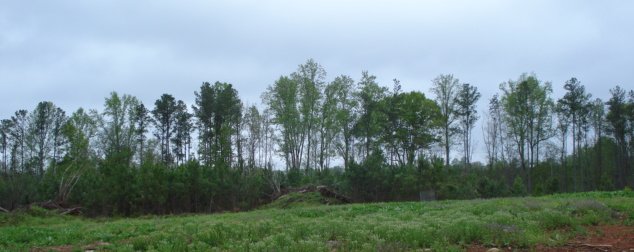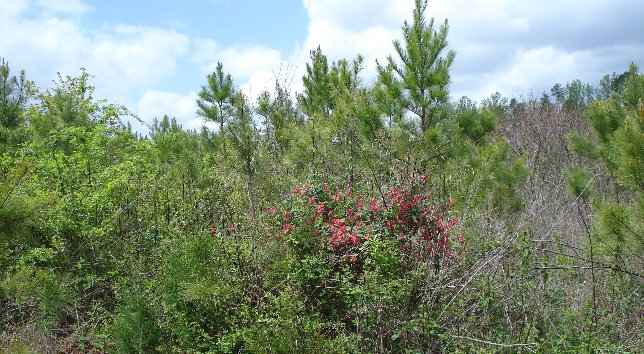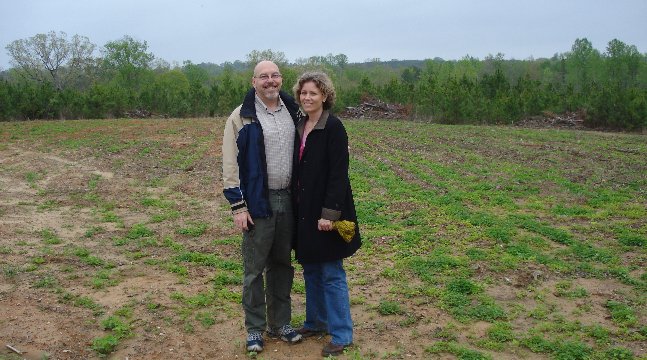I will be back in Iraq soon enough and will presumably write more exotic posts, but for now I am enjoying a life a little more ordinary so please excuse my more mundane posting. As you can tell, this spring a lot of my time is being spent my forestry matters. You gotta have a hobby.
Below – the trees are a little tight in places.

Chrissy and I went to Southside Virginia to check into pre-commercial thinning of our pines and maybe get some biosolids next year. We currently have around 1000-1500 loblolly per acre. That is way too many. We were lucky that we had a very high survival rate and we got a good number of volunteers, but now it is time to reduce that to around 500 an acre. The State of Virginia in its wisdom is offering cost-share this year, in order to fight the southern pine beetle (too many trees are less robust and more likely to be attacked by disease and insects), so we will have it done. It will shorten the rotation by a couple of years, improve wildlife habitat, help the stand resist the pine beetle and make it easier to walk around the property. It is just a good idea, like thinning a flower garden except a lot bigger.
Below is the best wildlife plot so far. It is almost completely filled in.

We also checked out our recently planted wildlife plots. We have five plots; the biggest one is about an acre, planted in white clover and chicory. It adds significant diversity to the tree farm and makes the local animals healthier. I also like the look of the meadow to break up the landscape. Everything is coming in very well. There are all sorts of animals on the farm anyway.
Our pine lands were clearcut in 2003. Southern pine requires full sunlight, so this is the only managment option. It doesn’t look good the first year, but a clearcut plus around five years is one of the most productive and diverse wildlife habitats around, especially if you do a few things like wildlife plots and corridors. Southern pine fills 58% of America’s demand for timber. It is a fully sustainable resource and our pine lands are great places for wildlife & recreation.
The stream management zone have the biggest trees, mostly beech, oak and tulip-poplar with a holly understory and a fern forest floor.

We have around 30 acres in stream management zones and these provide corridors of mixed hardwood through the pine plantations, while preserving water quality. My water is clear, now that we have addressed some of the erosion issue at a couple places. Our water eventually runs into Albermale Sound in NC via Genito Creek, which runs through our land.The boys and I spread 40 tons of rip-rap last year and the year before. The banks have stabilized and vegetation is growing profusely where it the soil used to run into the water. I am surprised also to find little fish in some of the pools. Life is surprising that way. Another important thing we have is “vernal ponds” AKA mud holes with water. These ponds are important because they allow amphibians like frogs and salamanders to breed. The pond must be intermittent, i.e. dry up sometimes so as not to support a fish population that would eat the eggs. People tend not to like vernal ponds, because they are well…mud holes. They drain them and fill them in, thereby helping to doom the local amphibian population.
Below is native honeysuckle. It blooms this time of year and brightens up the forest

The good thing about forestry is that you can have fun, make good investments, grow trees and be environmentally responsible all a the same time.
Below – Chrissy & me in front of one of wildlife plots. This one is well within the pine plantation and will probably be one of the better ones in the fullness of time. Wildlife plots spread out in the wood with irregular sides are the most productive. This will eventually have a soft edge of taller growth. The clover and chicory will fill in. We wanted to break up the compressed dirt. Nothing could grow in the compressed clay until it was broken up an limed. This plot was created in October. Recent much needed rain will help it grow.

